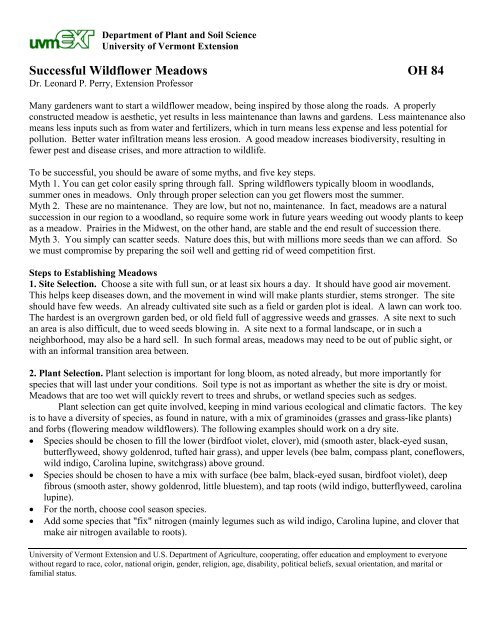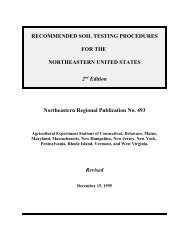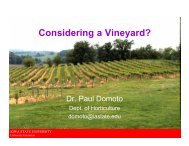Successful Wildflower Meadows OH 84 - University of Vermont
Successful Wildflower Meadows OH 84 - University of Vermont
Successful Wildflower Meadows OH 84 - University of Vermont
You also want an ePaper? Increase the reach of your titles
YUMPU automatically turns print PDFs into web optimized ePapers that Google loves.
Department <strong>of</strong> Plant and Soil Science<br />
<strong>University</strong> <strong>of</strong> <strong>Vermont</strong> Extension<br />
<strong>Successful</strong> <strong>Wildflower</strong> <strong>Meadows</strong> <strong>OH</strong> <strong>84</strong><br />
Dr. Leonard P. Perry, Extension Pr<strong>of</strong>essor<br />
Many gardeners want to start a wildflower meadow, being inspired by those along the roads. A properly<br />
constructed meadow is aesthetic, yet results in less maintenance than lawns and gardens. Less maintenance also<br />
means less inputs such as from water and fertilizers, which in turn means less expense and less potential for<br />
pollution. Better water infiltration means less erosion. A good meadow increases biodiversity, resulting in<br />
fewer pest and disease crises, and more attraction to wildlife.<br />
To be successful, you should be aware <strong>of</strong> some myths, and five key steps.<br />
Myth 1. You can get color easily spring through fall. Spring wildflowers typically bloom in woodlands,<br />
summer ones in meadows. Only through proper selection can you get flowers most the summer.<br />
Myth 2. These are no maintenance. They are low, but not no, maintenance. In fact, meadows are a natural<br />
succession in our region to a woodland, so require some work in future years weeding out woody plants to keep<br />
as a meadow. Prairies in the Midwest, on the other hand, are stable and the end result <strong>of</strong> succession there.<br />
Myth 3. You simply can scatter seeds. Nature does this, but with millions more seeds than we can afford. So<br />
we must compromise by preparing the soil well and getting rid <strong>of</strong> weed competition first.<br />
Steps to Establishing <strong>Meadows</strong><br />
1. Site Selection. Choose a site with full sun, or at least six hours a day. It should have good air movement.<br />
This helps keep diseases down, and the movement in wind will make plants sturdier, stems stronger. The site<br />
should have few weeds. An already cultivated site such as a field or garden plot is ideal. A lawn can work too.<br />
The hardest is an overgrown garden bed, or old field full <strong>of</strong> aggressive weeds and grasses. A site next to such<br />
an area is also difficult, due to weed seeds blowing in. A site next to a formal landscape, or in such a<br />
neighborhood, may also be a hard sell. In such formal areas, meadows may need to be out <strong>of</strong> public sight, or<br />
with an informal transition area between.<br />
2. Plant Selection. Plant selection is important for long bloom, as noted already, but more importantly for<br />
species that will last under your conditions. Soil type is not as important as whether the site is dry or moist.<br />
<strong>Meadows</strong> that are too wet will quickly revert to trees and shrubs, or wetland species such as sedges.<br />
Plant selection can get quite involved, keeping in mind various ecological and climatic factors. The key<br />
is to have a diversity <strong>of</strong> species, as found in nature, with a mix <strong>of</strong> graminoides (grasses and grass-like plants)<br />
and forbs (flowering meadow wildflowers). The following examples should work on a dry site.<br />
• Species should be chosen to fill the lower (birdfoot violet, clover), mid (smooth aster, black-eyed susan,<br />
butterflyweed, showy goldenrod, tufted hair grass), and upper levels (bee balm, compass plant, coneflowers,<br />
wild indigo, Carolina lupine, switchgrass) above ground.<br />
• Species should be chosen to have a mix with surface (bee balm, black-eyed susan, birdfoot violet), deep<br />
fibrous (smooth aster, showy goldenrod, little bluestem), and tap roots (wild indigo, butterflyweed, carolina<br />
lupine).<br />
• For the north, choose cool season species.<br />
• Add some species that "fix" nitrogen (mainly legumes such as wild indigo, Carolina lupine, and clover that<br />
make air nitrogen available to roots).<br />
<strong>University</strong> <strong>of</strong> <strong>Vermont</strong> Extension and U.S. Department <strong>of</strong> Agriculture, cooperating, <strong>of</strong>fer education and employment to everyone<br />
without regard to race, color, national origin, gender, religion, age, disability, political beliefs, sexual orientation, and marital or<br />
familial status.
• Finally, use a mix <strong>of</strong> species that will grow and stabilize quickly in the first year (black-eyed susan, lavender<br />
hyssop), over two to four years (coneflowers, bee balm, spiderwort), and for the long term (butterflyweed,<br />
wild indigo, blazing star, compass plant).<br />
If all this seems too complex, buy a good quality seed mix from a reputable supplier. When it comes to these<br />
seeds, you truly get what you pay for. Inexpensive mixes <strong>of</strong>ten contain mainly annuals which are gone after the<br />
first year, species not native to your area, seeds that have poor germination, potential weedy species, or just a lot<br />
<strong>of</strong> seed debris.<br />
Another consideration under species selection, whether you buy a mix or make your own mixture, is<br />
whether you want a short term (1 to 5 years) or longer term meadow. In the former you may have more annuals<br />
for color up front, being out competed with weeds after a few years. A long term meadow may have mainly<br />
perennials which may take several years to begin a good display, but will last and out compete many weeds.<br />
3. Site Preparation. This is the step <strong>of</strong>ten overlooked, yet the key to success or failure. Since these<br />
wildflowers are usually less competitive than weeds, the site should contain no weeds or weed seeds. Unless<br />
the site has been cultivated already, with few to no weeds, there are several methods you may use.<br />
You may smother vegetation with black plastic for a whole growing season. You may also smother with<br />
thick layers <strong>of</strong> leaves, grass clippings, or newspapers covered with these. Another method is to plant a summer<br />
buckwheat crop, cut and tilled in before going to seed, followed by fall planting <strong>of</strong> winter wheat, cut and tilled<br />
in late winter. You may need to repeat this a second season. Or you may repeat deep soil tillage every three<br />
weeks for a full growing season. If a lawn with no weeds, remove the sod using a sod-cutter that can be rented<br />
from equipment rental firms. Many use a systemic herbicide, but avoid those that are residual (last in the soil).<br />
4. Sowing or Planting. You may sow in spring or early summer, which favors grasses over the forbs. Keep the<br />
spring-sown meadow watered as you would a newly seeded lawn, <strong>of</strong>ten for a month or two. Sowing in early<br />
fall favors the forbs, as some grass seeds rot then. Since many seeds will either not germinate until the<br />
following spring, or germinate and not grow until then, you should also use annual rye as a winter cover crop<br />
with fall sowings. Avoid sowing in mid to late summer when there may be drought, seeds drying out before<br />
germinating. For sowing, aim for about 80 seeds per square foot. In several years this will result in one or two<br />
plants in this space. Of this number per square foot, for spring sowing use about 60 forb and 20 grass seeds.<br />
This is about 9 lbs. and 3 lbs. per acre. For fall sowing, use a higher proportion <strong>of</strong> grass seeds.<br />
For small areas (for instance under 1000 square feet), consider using already-germinated small plants<br />
you can buy in trays as "plugs". These are more costly than seeds, but will establish much quicker. You can<br />
find these from specialty suppliers, either local, mail-order, or online.<br />
Number <strong>of</strong> plants <strong>of</strong> any one type will depend on how you will be viewing the meadow. If seeing it<br />
from a distance, you'll want to use larger numbers <strong>of</strong> each plant type, and place them in sweeping masses. If a<br />
small area, or one viewed at close range, you may have few <strong>of</strong> any one type plant, and have them all mixed.<br />
5. Post-planting management. In the first two years, seeds <strong>of</strong> annual and biennial weeds still in the soil or<br />
blown in will grow faster than your perennial wildflowers. Don't allow such weeds the first year to get above<br />
one foot tall before cutting back to four to six inches high. The wildflowers will, for the most part, remain short<br />
and below this height. The second year, cut back to about one foot high since plants will be larger. A weed or<br />
string trimmer works well for this. Don't pull weeds, as this may also disturb wildflower seedlings. Don't use<br />
herbicides as these may drift, killing large patches <strong>of</strong> both weeds and wildflowers!<br />
In the third and future years, burn <strong>of</strong>f the meadow (if this is allowed in your area, and by following local<br />
laws on burning), or mow it close to the ground. This should be done in late fall or early spring, removing the<br />
debris from mowing. This exposes the soil to the rapid warmth from the sun in spring, encouraging your<br />
wildflowers over cool-season weeds. Learn your wildflowers, and over the years you can selectively weed out<br />
any weeds or woody plant seedlings.<br />
<strong>OH</strong> <strong>84</strong> 1/05







